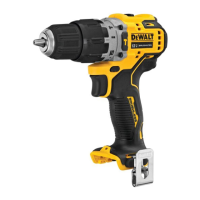ENGLISH
10
Hammerdrilling
DCD706 Only
Important: Use carbide-tipped or masonry bits rated for
percussion drillingonly.
1. Select the desired speed/torque range using the speed
selector
6
to match the speed and torque to the
planned operation. Turn the mode selection collar
5
to
the hammerdrillsymbol.
Performing an Application (Fig. A)
WARNING: To reduce the risk of personal
injury, ALWAYS ensure workpiece is anchored or
clampedfirmly.
WARNING: Always wait until the motor has come to
a complete standstill before changing the direction
ofrotation.
Prior to Performing Work
Install the appropriate bit or accessory into the chuck. Refer
to Installing a Bit or Accessory into a KeylessChuck.
WARNING:
• Do not use this tool to mix or pump easily
combustible or explosive fluids (benzine,
alcohol,etc.).
• Do not mix or stir flammable liquids
labeledaccordingly.
Screwdriving
Your tool has a clutch with adjustable torque for driving
and removing a wide array of fastener shapes and sizes. The
numbers 1–15 on the mode selection collar
5
are used to
set a torque range for screwdriving. The higher the number
on the collar, the higher the torque and the larger the
fastener which can be driven.
Fig.F
7
NOTE: Continuous use in variable speed range is not
recommended. It may damage the switch and should
beavoided.
NOTE: The first time the tool is run after changing the
direction of rotation, you may hear a click on start up. This is
normal and does not indicate a problem.
Worklight (Fig. F)
CAUTION: Do not stare into worklight. Serious eye
injury could result.
The worklight
7
is located on the foot of the tool. The
worklight is activated when the trigger is depressed. If the
trigger switch remains depressed, the worklight will remain
on in allmodes.
The beam will automatically turn off 20 seconds after the
trigger switch isreleased.
NOTE: The worklight is for lighting the immediate work
surface and is not intended to be used as a flashlight.
1. Turn the mode selection collar
5
to the
desiredposition. Refer to Mode Selection.
2. Pull the trigger switch applying pressure in a straight
line with the bit until the fastener is seated at the
desired depth in the workpiece.
Recommendations for Screwdriving
• Start with lower torque settings, then advance to higher
torque settings to avoid damage to the workpiece
orfastener.
• Make some practice runs in scrap or on unseen areas of
the workpiece to determine the proper position of the
mode selection collar.
Drilling
IMPORTANT: For MASONRY, such as brick, cement, cinder
block, etc., use carbide-tipped masonry bits.
1. Turn the mode selection collar
5
to the drillsymbol.
Refer to Mode Selection.
2. Place drill bit in contact with the workpiece.
NOTE: Use sharp drill bit only.
3. Pull the trigger switch applying pressure in a straight
line with the bit until it reaches the desired depth.
WARNING: Tool may stall if overloaded causing a
sudden twist. Always expect the stall. Grip the tool
firmly to control the twisting action and avoidinjury.
4. Keep the motor running when pulling the bit back out
of a drilled hole to preventjamming.
Recommendations for Drilling
• When drilling, always apply pressure in a straight line
with the bit, but do not push hard enough to stall the
motor or deflect thebit.
• IF THE TOOL STALLS:
- RELEASE TRIGGER SWITCH IMMEDIATELY,
remove drill bit from work, and determine cause
ofstalling.
- DO NOT DEPRESS TRIGGER SWITCH ON AND
OFF IN AN ATTEMPT TO START A STALLED
TOOL—THIS CAN DAMAGE THETOOL.
- To minimize stalling or breaking through the
material, reduce pressure on drill and ease the bit
through the last fractional part of thehole.
• Large holes (5/16" to 1/2" [7.9 mm to 12.7 mm]) in steel
can be made easier if a pilot hole (5/32" to 3/16" [4 mm
to 4.8 mm]) is drilledfirst.
• If drilling thin material or material that is prone to
splinter, use a wood “back-up” block to prevent damage
to theworkpiece.

